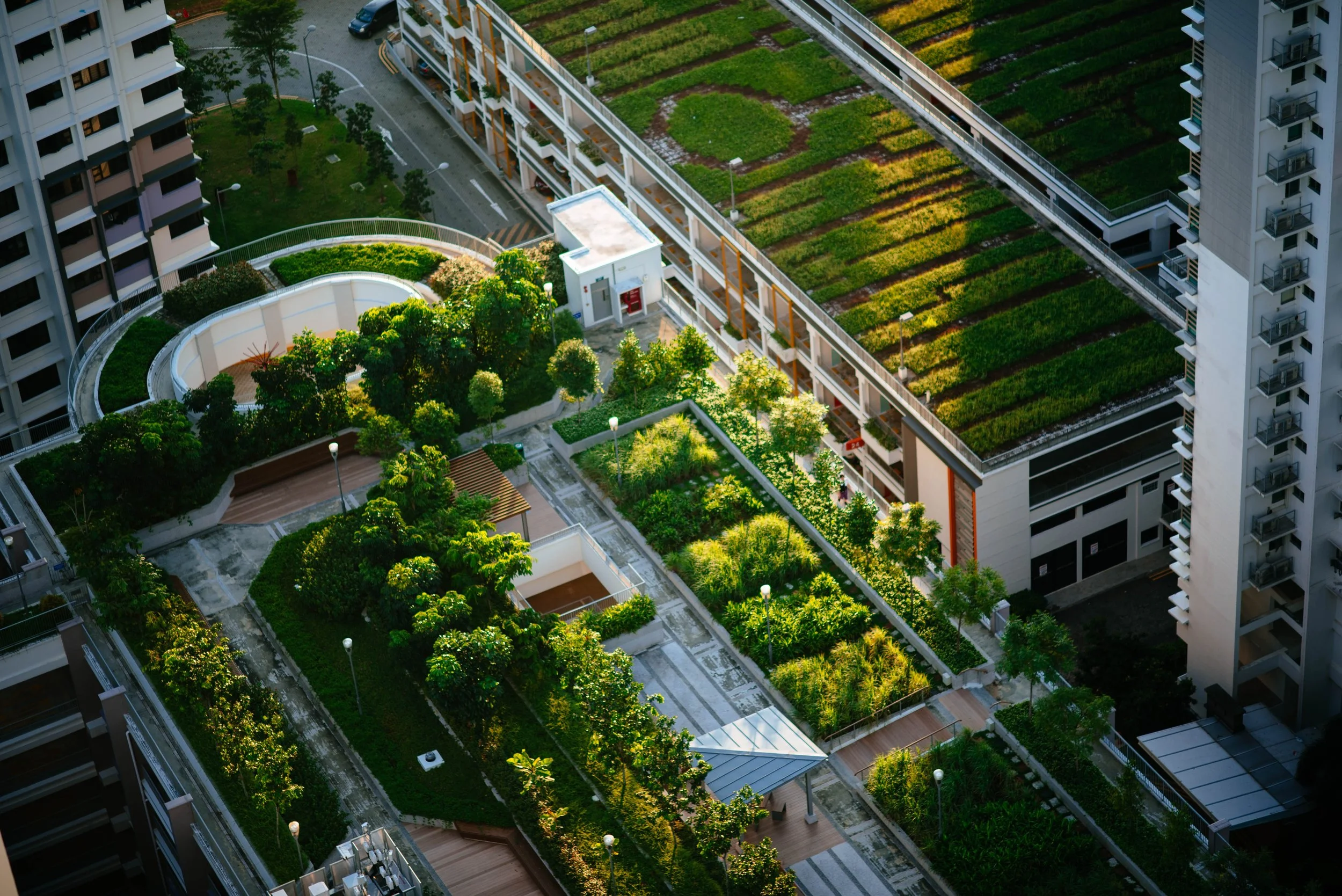Discover how green roofs and vertical gardens are revolutionizing urban housing in Southeast Asia. Explore the environmental, economic, and social benefits of these sustainable installations.

PHOTO: CHUTTERSNAP on Unsplash
Living in an urban area is indeed full of opportunities, but it can also be cramped, dirty, polluted, and noisy. That is why it is important to have some ways to embrace a lifestyle with access to plenty of plants, even in the city.
Green roofs and vertical gardens can give urban housing a new face. They can provide fresh air, reduce noise pollution, and create a more inviting and sustainable environment.
Introduction to Green Roofs and Vertical Gardens
In the fast-paced world of urban development, incorporating green spaces into architecture has become a global trend, especially in the densely populated cities of Southeast Asia (SEA). Green roofs and vertical gardens offer a solution to these cities’ environmental and social challenges, promoting sustainability, eco-friendly living, and a net-zero lifestyle.
Environmental Benefits of Urban Green Spaces
One of the critical advantages of green roofs and vertical gardens is their ability to combat the urban heat island effect, which is particularly crucial in SEA cities known for their high temperatures.
These green spaces provide natural insulation, reducing the need for air conditioning and resulting in significant energy savings. Additionally, they improve air quality by absorbing pollutants such as carbon dioxide while releasing oxygen into the atmosphere, promoting sustainable living.
Another environmental benefit of green roofs is their rainwater management capabilities. By absorbing rainwater, these eco-friendly installations reduce the burden on stormwater systems, minimize flooding, and contribute to the replenishment of groundwater supplies. Furthermore, vertical gardens and green roofs act as urban oasis for biodiversity, providing habitats for insects, birds, and even small animals in urban areas where natural green spaces are scarce.
Case Studies: Successful Green Roof Projects in SEA
Several exemplary projects in Southeast Asia have effectively integrated green roofs and vertical gardens into their architecture, inspiring future developments. One such project is the Pinnacle@Duxton in Singapore, a public housing complex adorned with green rooftops and impressive vertical gardens. Residents have reported lower energy bills and a stronger sense of community well-being thanks to the integration of these sustainable features.
Another noteworthy project is the Vertical Village in Kuala Lumpur, Malaysia. Designed with sustainability and eco-friendly living in mind, the development features green roofs and vertical gardens that not only beautify the buildings but also provide natural cooling and rainwater management. Feedback from residents highlights the positive impact on mental health and the sense of urban connection these green spaces foster.
Economic and Social Advantages
The economic benefits of green roofs and vertical gardens cannot be overlooked, too. These installations reduce energy consumption by providing natural insulation, resulting in long-term cost savings. Moreover, studies have shown that properties with green roofs or vertical gardens command higher property values, making them a sound investment in sustainable architecture.
Meanwhile, from a social perspective, these green spaces enhance community well-being. Access to nature within urban environments has been proven to reduce stress, improve mental health, and foster a sense of connection and belonging. By incorporating green roofs and vertical gardens, urban housing developments can create vibrant communities committed to sustainable living and a net-zero lifestyle.
Challenges and the Road Ahead
While the benefits are clear, there are challenges to overcome when implementing green roofs and vertical gardens in tropical climates. Technical considerations, such as ensuring proper water management and irrigation systems, can be more complex due to the heavy rainfall and humidity experienced in SEA cities. Regular maintenance is also significant to ensure the longevity and effectiveness of these installations.
Advocacy and policy recommendations are essential to encourage the broader adoption of sustainable architecture in SEA. Governments and urban development authorities should incentivize the incorporation of green roofs and vertical gardens through regulations and financial support.
In addition, knowledge sharing and collaboration between architects, engineers, and landscape designers is crucial in finding innovative solutions to the technical challenges faced in tropical climates.
Let’s Transform Urban Housing in SEA Together!
Green roofs and vertical gardens offer a practical and eco-friendly solution to densely populated SEA cities’ challenges. As an advocate for sustainable living, I believe that by incorporating sustainable architecture into urban housing developments, we can create communities committed to a net-zero lifestyle, promoting environmental, economic, and social sustainability.
Together, let us reimagine urban housing in SEA. Embrace sustainable construction materials and construction techniques, promote sustainable living, and build a future where green roofs and vertical gardens are not just features of innovative architecture but integral components of our net-zero lifestyles.
Co-create with BillionBricks! As we develop our next house model, we are open to your ideas and feedback, which we believe are essential to building a net-zero home that meets your needs and exceeds your expectations. We will share our own ideas and insights and explore ways in which we can collaborate. Contact us at: https://billionbricks.org/sign-up.
If you’re passionate about sustainable living and want to learn more, we recommend you dive into our article that’s filled with valuable insights. Take a look at Modular Homes: A Sustainable Solution for Urban Southeast Asia.
Resources:
-
Isaiah Dauda, Halil Zafer Alibaba. Green Roof Benefits, Opportunities, and Challenges. Retrieved from https://www.researchpublish.com/upload/book/GREEN%20ROOF%20BENEFITS-8256.pdf
-
Singapore Tourism. Pinaccle@Duxton. https://www.visitsingapore.com/see-do-singapore/architecture/modern/pinnacle-at-duxton/
-
Aliff Iskandar. The Urban Kampung: Reviving Malaysian Living Tradition Into The Modern City. Retrieved from https://issuu.com/aliffiskandar/docs/g1914133_magazine_report_latest_draft_compressed
-
Janet Clements. The Green Edge: How Commercial Property Investment in Green Infrastructure Creates Value. Retrieved from https://www.nrdc.org/sites/default/files/commercial-value-green-infrastructure-report.pdf
-
Amy Chomowicz. Why don’t all public buildings have green roofs? Or all large private buildings (e.g., businesses)? Would this be a good idea? What would it take to make it happen and to make it worthwhile?. Retrieved from https://www.thenatureofcities.com/2015/08/12/why-dont-all-public-buildings-have-green-roofs-or-all-large-private-buildings-e-g-businesses-would-this-be-a-good-idea-what-would-it-take-to-make-it-happen-and-to-make-it-worthwhile/




